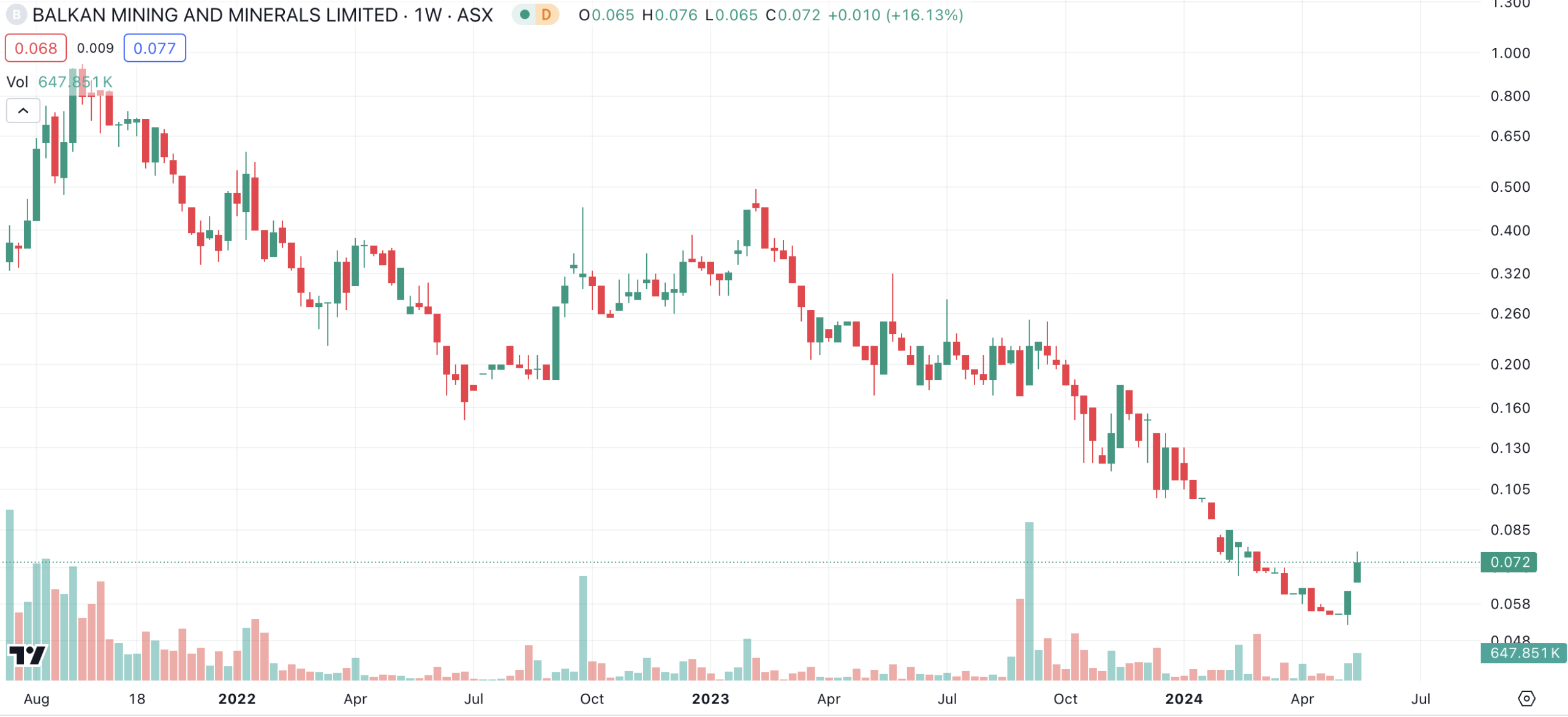Resources stocks for Dummies: Here’s how to get started in the ASX’s most exciting sector in 2025
![]() Nick Sundich, May 20, 2025
Nick Sundich, May 20, 2025
Over a third of companies listed on the ASX are resources stocks. Resources stocks offer exposure to many different commodities and can satisfy a wide range of risk appetites.
At first glance, you might think that resources stocks are a good investment. While they can be, there are a few things you need to know before you invest.
In this article we provide a general overview of the commodities that resources stocks are searching for, the ways to make money from resources stocks, the stages in a company’s life and the five key things investors need to consider before making an investment. Let’s go!
Not all resources stocks are alike
Resources stocks are typically either explorers or producers. Producers are companies that are producing commodities from active mines, while explorers are companies searching for the next big mine.
The term ‘mining stocks’ is often used interchangeably with both, although this is only a correct term for producers, not explorers.
Even among producers and explorers, there are many different companies that focus on different commodities in different regions. Some have projects or mines in Australia, others in the Americas, others in Africa, a handful even have projects in Europe or Asia.
Commodities that ASX resources stocks are mining or searching for
The four most common commodities that resources stocks focus on are gold, iron ore, copper and lithium, although there are several others, including nickel, graphite, silver, platinum/palladium, zinc, manganese and cobalt.
What about coal, oil, gas and hydrogen, you say? Even though these are natural resources, they are classified as ‘energy’ because of their end-use markets.
The most popular resources
Gold is popular metal for its end uses (particularly in jewellery and electronics) and because it is perceived as a hedge against inflation, in theory. In practice, the price of gold fluctuates and stocks go in an out of favour accordingly. Gold stocks have stagnated for the past couple of years as the global economy enjoyed a post-pandemic boom and more popular industrial metals went on a bull run.
Iron ore is a critical material in steel manufacturing. There aren’t too many companies in the iron ore space, but the most popular is $69bn miner Fortescue (ASX:FMG). Given that China is the world’s biggest buyer of iron ore, iron ore prices have followed the fate of the Chinese economy, more than halving since early 2021.
Copper is also an important industrial mineral, used in electrical equipment, such as wiring and motors, construction and industrial machinery. Although copper prices have been hindered by slower economic growth, the supply shortage will moderate any short-term impact and help it in the longer-term.
Lithium, is the most popular battery metal in the sense that it is the most important to EV batteries. Many lithium stocks were sold off in 2023-4 due to the lithium bear market. There is significant debate among analysts as to whether or not prices will recover to 2021-22 levels, even with the forthcoming demand for the commodity.
Groups of commodities
You may often hear certain terms ‘precious metals’, ‘base metals’ and ‘battery metals’ used to refer to different groups of commodities.
Precious metals – including gold, silver, platinum and palladium – are so-called because they aren’t as common and cheap as other metals. Base metals on the other hand – such as copper and zinc – tend to be common and inexpensive.
Battery metals are metals that are used in high-performance batteries, particularly for electric vehicles. These include lithium, nickel, graphite, cobalt and manganese.
Rare earths allude to fifteen elements in the lanthanide series on the periodic table of elements. These are commonly used in a wide variety of applications, particularly high power magnets. Two examples include Neodymium and Praseodymium.
Mineral sands allude to commodities that are found in sand environments, these can be near waterways and beaches, or in the desert. Examples of mineral sands include zircon, titanium, tungsten and rutile.
How to make money from resources stocks
Simply put, the most common way to make money from resources stocks is to buy a stock then sell it for higher than you bought it for. Of course, that is oversimplifying it, but in essence, you need to identify a good company before other investors also start to recognise that it is good.
The biggest return would come from investing in an explorer that stumbles across the next big mine. But finding the right company is very difficult and may require a lot of waiting. Chalice (ASX:CHN) proved this was possible, though. In March 2020, it stumbled across the Julimar deposit and went from 20c a share to over $10 a share in 18 months. Shares have retreated ever since for reasons outlined here, although the share price remains well ahead of where it was prior to the discovery of Julimar.

Source: Chalice Mining AGM Presentation November 2021
The most notable example before Chalice was Sirius Resources. It stumbled across the Greenbushes lithium mine and went from 5c a share in 2012 to $4.93 in 2015, at which point it was acquired by IGO.
More realistic scenarios to make money from resources stocks
Another way to make money from resources stocks is if your company is being acquired. Takeovers are typically done at a premium to the actual share price just prior to the offer to increase the odds that it will be accepted.
This outcome is more common than a major discovery, but it is still rare. By the time a company enters production, it could be too expensive to be acquired. Alternatively, a company may have done enough exploration prior to production to make it appealing for a larger company to buy.
And of course, resources stocks can rise when their underlying commodity is enjoying favourable price activity on global metal exchanges. Commodity price increases can happen for a number of reasons and is worth an article in itself.
But the bottom line is that higher commodity prices can make explorers’ individual projects more appealing and potentially deliver higher revenues and margins to producers – if sustained over a longer time period, of course.
Why have resources stocks outperformed their peers?
As we mentioned in the introduction, resources stocks have tendency to outperform their peers in adverse economic times. In 2022, the S&P 500 fell by 16.7%, but the S&P Goldman Sachs Commodity Index rose by 8.7%. Now of course, in the last 12 months the latter indice trails the S&P 500 as it has been a tough time for most commodities other than gold. But the S&P Gold Index is up 40% in the 12 months to May 31, 2025 whilst the s&P 500 is only up 12%.
Each and every commodity has its own underlying story, so it is difficult to attribute any single reason to why the ‘resources sector’ performs the way it does. Nonetheless battery metal companies have struggled amidst a retreat in commodity prices, given a glut in supply of electric vehicles as demand has slowed. On the other hand, gold has outperformed due to the strong performance of many global miners and heavy industry M&A activity.
Supply chain disruptions have also helped the cause of certain companies with local projects – investors and end customers are willing to pay a premium for a product they can receive sooner.
The 4 Stages in the lifecycle of a Resources Stock
Resources stocks tend to be at one of the following four stages: Exploration, Studies and Offtake, Financing and Construction, and Mining.
Stage One: Exploration
The first stage in the lifecycle of resources stocks is exploration. Companies will explore their projects for minerals, initially through surveying and rock sampling, followed by drilling later on.
Companies will gradually release results to the market and investors may get excited about individual results. Investors should not get too carried away with these results, however. All of these must be in line with the Australasian JORC (Joint Ore Reserves Committee) Code, the industry’s code for reporting exploration results.
Each commodity has a general rule of thumb for what is considered high-grade. With gold, for instance, anything above 5g/t is typically considered high grade. But other factors need to be considered as well, such as the depth where the grade was found and the total size of the intercept.
Stage Two: Studies and off-take
As resources stocks explore and uncover more of a potential resource, they conduct studies to examine the potential of a resource and whether or not it can be mined or extracted economically.
The four stages are: Scoping, Preliminary Feasibility Study (PFS), Definitive Feasibility Study (DFS) and Bankable Feasibility Study (BFS).
By the BFS stage, a company should have a high degree of confidence that there is a sufficient resource and that it can be extracted economically. Indeed the purpose of the BFS is to allow financial institutions to assess the company’s credit-worthiness for project financing.
Investors should look for the phase ‘Measured’ Resources as opposed to Inferred or Indicated. A measured resource represents the highest level of geologic knowledge and confidence, while Inferred or Indicated resources represent a lower level of confidence.
In earlier stages of mining studies, you may hear about proven or probable reserves. These terms are self-explanatory – proven is economically recoverable with high certainty whereas probable is more like a 50-50 chance.
At later stages, the company may also look for end-customers for its product, so they might sign deals with potential clients. These may be non-binding letters of intent, or binding offtake deals.
Stage Three: Financing and construction
The next step is to secure capital for the project and to begin construction. This may take 12-24 months depending on the project design and engineering. It is not uncommon, however, for the project construction to be occur in multiple stages, allowing production to begin at a smaller scale while the rest of the project is still being built.
Although projects will require ongoing capital when they are up and running, a significant amount of finance will have to be spent before a single cent of revenue has been made from the project.
Stage Four: Mining
Once the company has completed construction, production can begin. But exploration work may still continue in order to expand the Life of Mine by expanding the resource. Companies will also need to ensure that their operations remain profitable, adjusting the engineering if needed.
The biggest resources stocks will have multiple projects up and running at any given time and can easily transition out of projects that are not working or have reached the end of their life with minimal impact to shareholder value. But even when mining ends, it may not be the end for the project. Explorers may take over the project at a cheap price and give the project a new phase of life by discovering further resources there.
One recent example of this was Bellevue Gold (ASX:BGL), which has done this with its namesake gold project in WA.
Famous resources stocks
The two biggest resources stocks on ASX are BHP (ASX:BHP) and Rio Tinto (ASX:RIO). Others include iron ore giant Fortescue (ASX:FMG), lithium miner IGO (ASX:IGO) and gold producer Newcrest Mining (ASX:NCM).
Among small caps, there’s not really one very famous stock, because there are so many small companies at different stages of the journey and very few reach the ultimate dream of becoming a major miner. But some resources stocks that have nearly completed that journey include Chalice (ASX:CHN) and Liontown (ASX:LTR) that stumbled across major PGE and lithium deposits respectively.
Both companies have surged exponentially since their projects were discovered and are looking to enter production in the coming years.
The five key things you need to consider before investing in resources stocks
Investors need to consider five things before investing in any resources stock: Commodity prices, production costs, the jurisdiction, the management team and the valuation of the company.
1. Commodity prices
Commodity prices is arguably the most important consideration, because rising prices can mitigate higher production costs and cause a share price increase even without exciting news from your individual company.
Investors should be aware of the current commodity price, the reasons why it is where it is, potential uplifts and risks as well as what price levels would make a project economically unviable.
2. Production costs
Production costs may be mitigated as a concern by high commodity prices, but they should be considered nonetheless, not just because prices can fluctuate, but because a resources stock could still be less compelling than a peer with lower costs – even with higher prices sustained over a long-term time period.
3. Jurisdiction
The mining jurisdiction is important. You need to know specifically whether or not it will tolerate and support mining. Some countries, such as Australia and the USA, may have minimal risk for resources stocks. Others, particularly in Africa, are higher risk.
Tanzania has been a country renowned for sovereign risk in recent years after a suite of new laws were introduced in 2017 that allowed the government to tear up and renegotiate existing contracts, among other measures. Even though the government has changed since then, investors have still been weary of resources stocks that are exposed to this country.
4. Management team
The management team is another important thing to consider. Literally all resources stocks will tell you they have a highly experienced board and management team. That may be true in respect of the fact that most will have worked in the industry for several years, but they may not have experience in what they are aspiring to do – whether that is take a company from explorer to producer, or to discover enough of a resource to sell the project to another company. It is also good to have a mix of experience, some geologists and others dealmakers.
5. The valuation
Finally, investors need to consider the valuation. Investors should look at multiples such as EV/EBITDA, P/E and EV/Resource when considering whether or not to invest. They should also consider recent share price movements – if a company has gone on a ‘run’, whether it is because of the commodity price or maybe because there has just been one good hit, there is always the risk that an investment will not work out.
One example is Balkan Metals and Mining (ASX:BMM). This resources stock rocketed from 20c at IPO to over 90c after a few good hits at its project in Serbia and a surging lithium price. But shares retreated over the next couple of years as investor took profits and used their money to chase other lithium stocks with more recent hits.

Balkan Metals and Mining (ASX:BMM) share price chart, log scale (Source: TradingView)
Investing in resources stocks represents both a big opportunity and a big risk
Investing in resources stocks is a significant opportunity, offering the potential for returns well ahead of the market. But investors need to do a lot more homework than they would have to do with some other sectors. The resources sector is not a sector for novices or risk-wary investors, regardless of the size of the companies your looking to invest in.
What are the Best ASX Resources Stocks to invest in right now?
Check our buy/sell tips
Blog Categories
Get Our Top 5 ASX Stocks for FY25
Recent Posts
Greatland Gold’s ASX Debut: A New Chapter for WA’s Mining Landscape
Greatland Gold is targeting a cross-listing on the Australian Securities Exchange (ASX) and the London AIM market through its subsidiary,…
Emerging Trends: ESG Investing and the Rise of Sustainable Portfolios
In recent years, ESG (Environment, Social, and Governance) investing has become a global financial and social phenomenon. As of 2025,…
Meet TopCo: A new company to be born from the $14bn merger of Brickworks and Soul Pattinson
Investors have just heard about TopCo, a company being born from $14bn merger of Brickworks (ASX:BKW) and Washington H. Soul…



